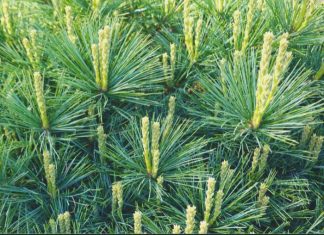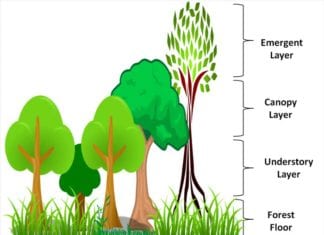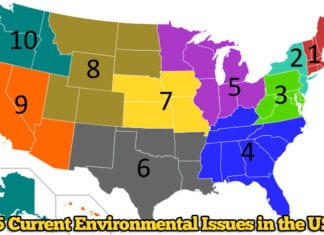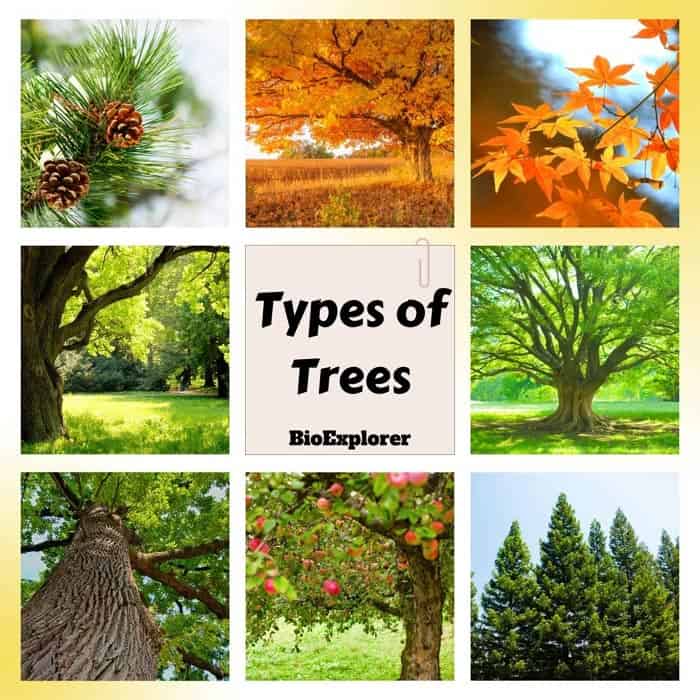
Types of Trees: As the poet Joyce Kilmer once beautifully expressed, “I think that I shall never see / A poem lovely as a tree“. Truly, trees stand as a testament to the captivating wonders of our natural world. Whether it be the towering redwoods of California or the humble apple trees found in New England, each species adds its element to the tapestry of our ecosystems.
Exploring tree classification takes us on a captivating journey into botany. It is an awe-inspiring expedition that unravels the intricacies of tree taxonomy. This system reflects both the diversity and interconnectedness of life on our planet. Every category, from angiosperms to Gymnosperms from trees that shed their leaves to evergreen trees that stay lush throughout the year, unveils insights about a tree’s biology, role within its ecosystem, and ability to adapt to its surroundings.
In sections, we will embark on an exploration of the enchanting world of trees. We will delve into their types, examine their roles within our ecosystems, and appreciate their profound significance in our cultures. As we embark on this journey together, let us remember John Muirs’s words; “Between every two pines is a doorway to a new world“.
Table of Contents
Understanding Tree Taxonomy
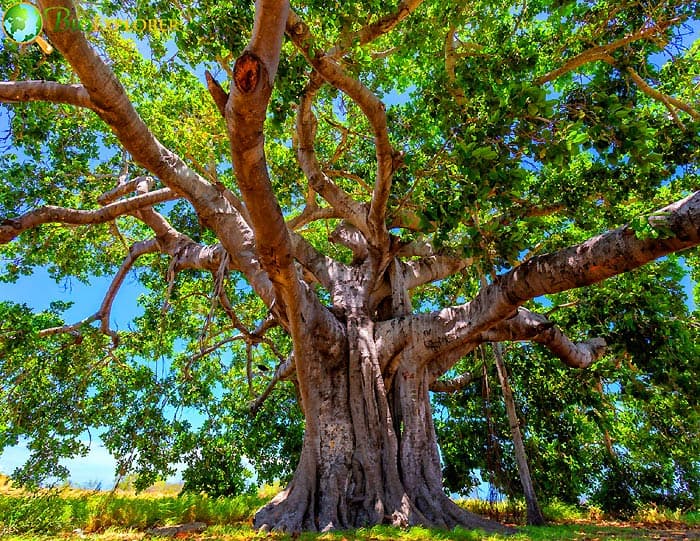
In botany, the definition of a “tree” is not as straightforward as it may initially appear. Then, being tied to a taxonomic group, the term refers to a particular plant growth form. When we use the word “tree“, we are describing a type of plant that typically has a trunk supporting itself and contains woody tissues. Additionally, these plants boast a crown composed of leaves or fronds.
These plants are generally perennial, meaning they have a two-year lifespan. They often grow to heights that surpass those of other plants.
Determining the classification for trees can be quite complex. Trees belong to families and orders within the plant kingdom, highlighting their diversity. For instance, coniferous trees such as pines and firs are part of the Pinaceae family. In contrast, broadleaf species, like oaks and beeches, fall under the Fagaceae family.
Furthermore, trees can be broadly categorized into two groups based on their seed structure;
- Angiosperms or flowering plants produce seeds enclosed within fruits. The majority of broadleaf trees fall into this category.
- Gymnosperms produce seeds that are not enclosed within fruits. Most needle-leaf trees belong to this group.
To truly grasp the diversity and importance of trees in our ecosystems, it is essential to have an understanding of their taxonomy. As we embark on this journey into the realm of trees, we will delve into these categories deeply, unveiling the captivating world of tree biology[1].
Broadleaf and Needleleaf: A Basic Classification
Two types of trees are classified by their leaf characteristics; broadleaf and needleleaf.
Broadleaf trees are known for their leaves that contain a good amount of chlorophyll, allowing them to efficiently carry out photosynthesis. Broadleaf trees can be further divided into two groups:
- Deciduous Broadleaf trees: These trees shed their leaves annually during the autumn season. This adaptation helps them conserve water during winter or periods of drought. Examples include oak, Maple, and birch trees.
- Evergreen Broadleaf trees; These trees retain their leaves all year round. This feature enables them to undergo photosynthesis whenever favorable conditions exist. Examples include Holly, Eucalyptus, and various tropical tree species.
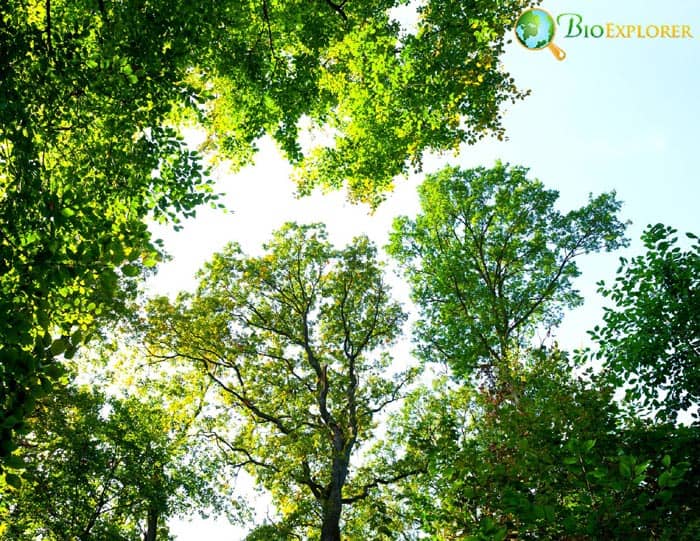
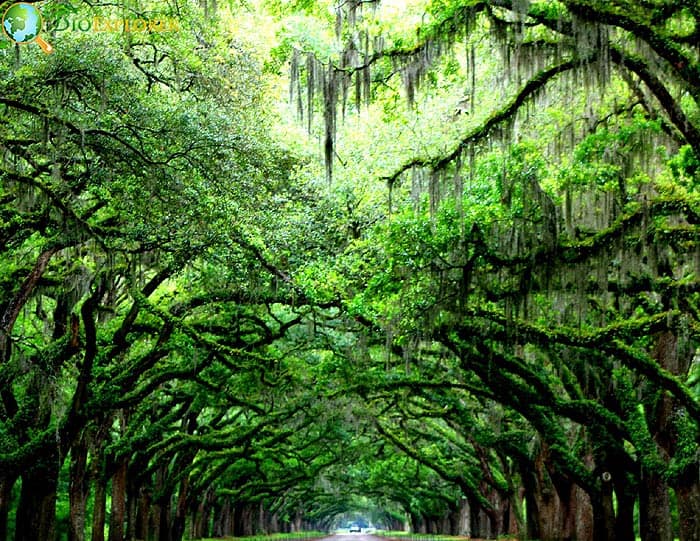
On the other hand, needle leaf trees have leaves that resemble needles;
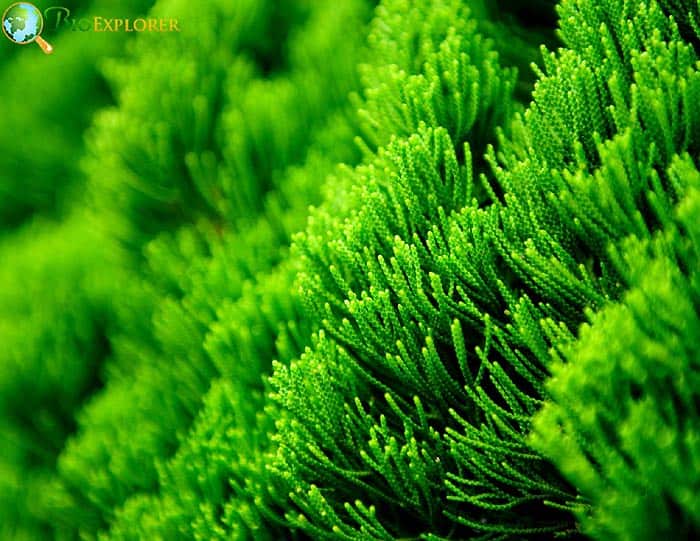
- Needleleaf trees are mostly evergreen and keep their leaves throughout the year. The needle-like shape of their leaves helps reduce water loss, making these trees well-suited for dry environments.
- Most coniferous tree species, like pine, fir, and spruce, fall under this category.
This basic classification provides a starting point for understanding the diversity among different types of trees. Nevertheless, it is crucial to remember that the realm of trees encompasses anomalies and divergences showcasing the malleable nature of the natural world.
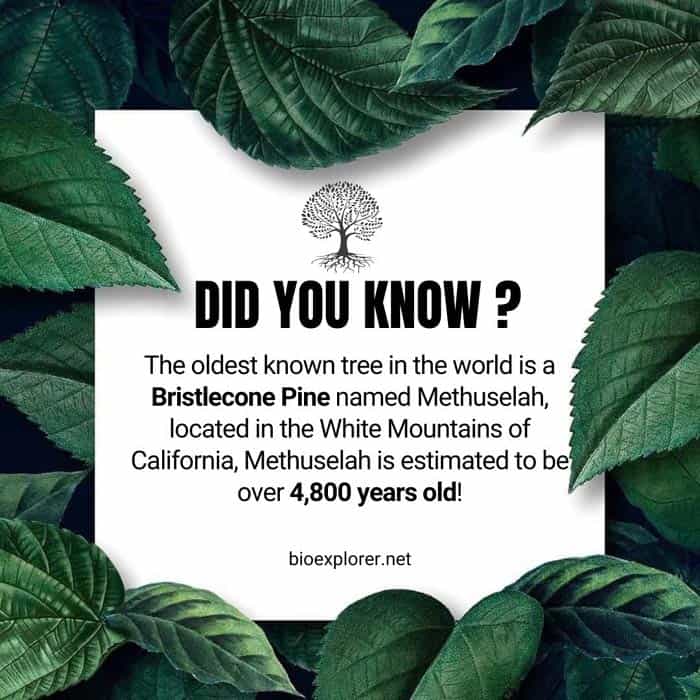
Angiosperms and Gymnosperms: A Biological Classification
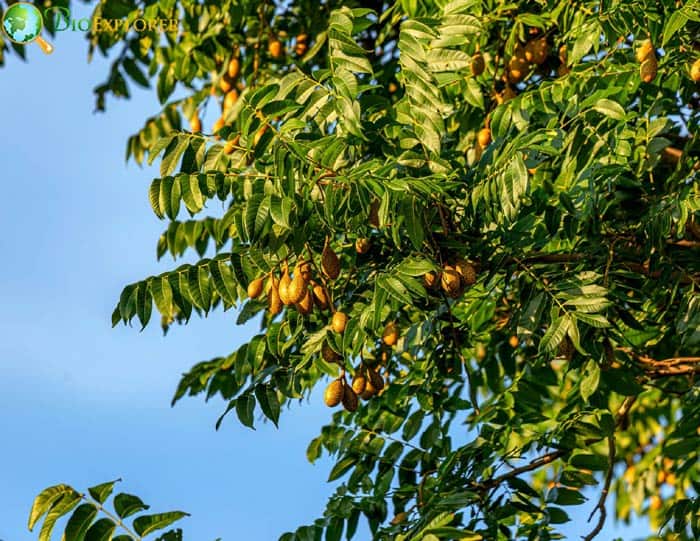
In botany, trees are categorized into two groups based on their biology: angiosperms and gymnosperms.
Angiosperms, or flowering plants, represent a group of land plants. They are characterized by their flowers, which play a role in reproduction. The seeds of angiosperms are enclosed within fruits, which develop from ovaries. This group encompasses a variety of tree species, including;
- Oak (Quercus): Renowned for their strength and long lifespan, oaks produce acorns that serve as a type of fruit.
- Maple (Acer); identifiable by their unique leaf shape and winged fruits.
- Apple (Malus): These trees are cherished for their fragrant blossoms and delicious fruit.
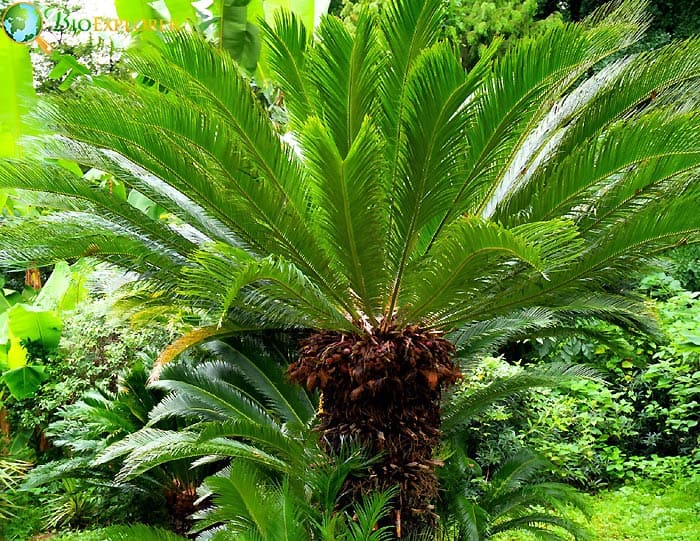
On the other hand, gymnosperms comprise a group of seed-producing plants whose seeds are not enclosed within fruits. The term “gymnosperm ” stems from words meaning “seed“. Conifers predominantly make up this group, characterized by bearing cones. Examples include;
- Pine (Pinus): Pines are recognized for their needle leaves and cones that house the seeds.
- Fir (Abies); Firs possess cones and flat needles.
- Spruces[2], known scientifically as Picea, are characterized by their drooping cones and needle-like leaves with four sides.
This biological classification helps us delve into the variety and intricacy of trees, unveiling the methods they employ to reproduce and thrive in their environment.
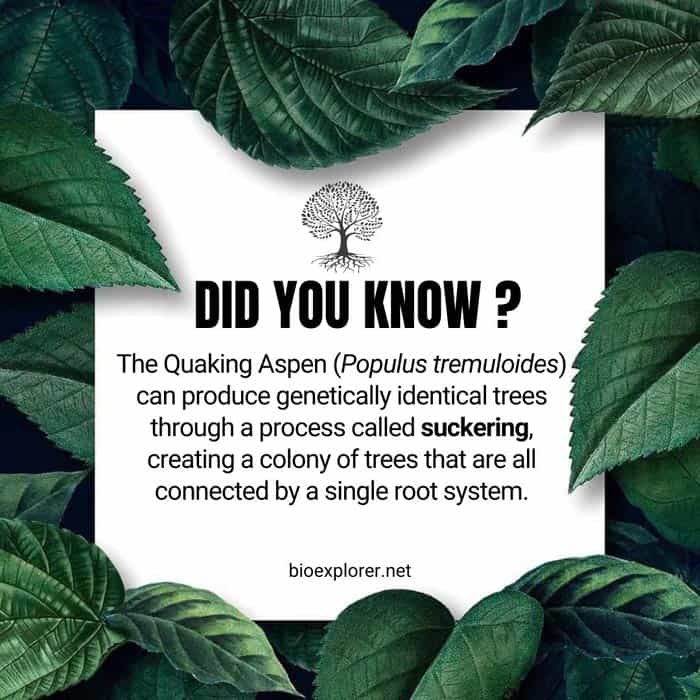
Types of Trees
Eastern White Pine
Common Tree Species in the United States
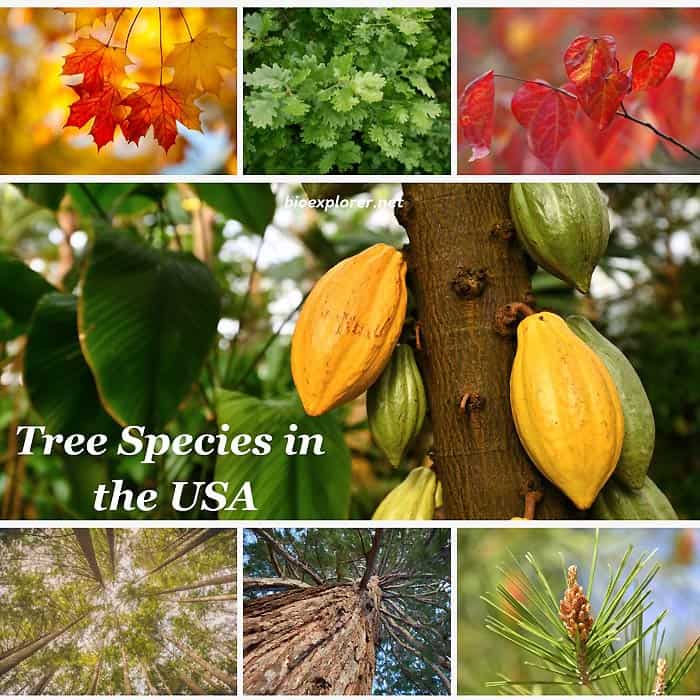
The United States harbors various tree species, each adapted to thrive in the conditions of its respective region. From the conifers that dominate the landscapes of the Pacific Northwest to the desert trees found in the Southwest, these diverse species play a vital role in shaping our nation’s natural environments and ecosystems[3].
- In the Northeastern part of the country, deciduous forests reign supreme, showcasing an abundance of broadleaf trees such as the Sugar Maple (Acer saccharum), renowned for its autumn hues and sweet sap. Another notable presence is the American Beech (Fagus grandifolia); it has gray bark and golden leaves during fall. Additionally, needle leaf trees like Eastern White Pine (Pinus strobus) can be commonly spotted in this region[4].
- The Southeastern region boasts a mix of evergreen trees contributing to its charm. The Live Oak (Quercus virginiana) symbolizes landscapes with sprawling branches and evergreen foliage. Meanwhile, the Loblolly Pine (Pinus taeda) holds value due to its timber-related benefits.
- While often associated with prairies, even the Midwest has forested areas. The White Oak (Quercus alba) is celebrated for its sturdy wood and abundant acorn production.
- The Eastern Redbud (Cercis Canadensis) is a tree well-liked in this area and known for its blossoms during the springtime. You can find some of the iconic tree species in the region in the country. The Coast Redwood (Sequoia sempervirens) and Giant Sequoia (Sequoiadendron giganteum) found in California are known to be among the largest trees. Additionally, the Douglas Fir (Pseudotsuga menziesii) dominates the Pacific Northwest[5]. Holds significance for its timber production.
- In conditions of the Southwest, you’ll find trees like Joshua Tree (Yuccaca brevifolia), which has a shape and symbolizes the Mojave Desert. The Pinyon Pine (Pinus edulis) and Utah Juniper (Juniperus osteosperma) are also commonly found in this region.
Each tree species plays a role within their ecosystems as they provide shelter for wildlife, generate oxygen, and offer essential human resources. Moreover, they contribute to enhancing the beauty of their regions, such as showcasing fall colors in Northeast areas or displaying majestic redwoods in Western locations.
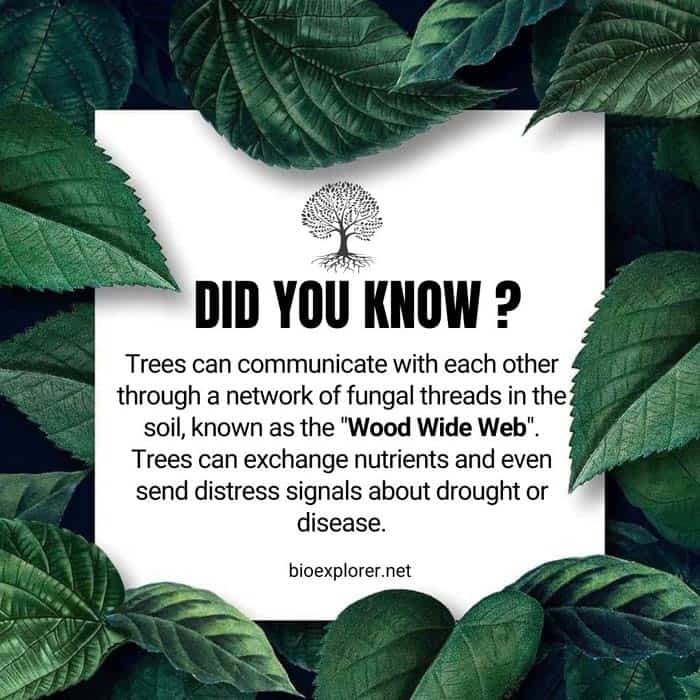
Trees Around the World
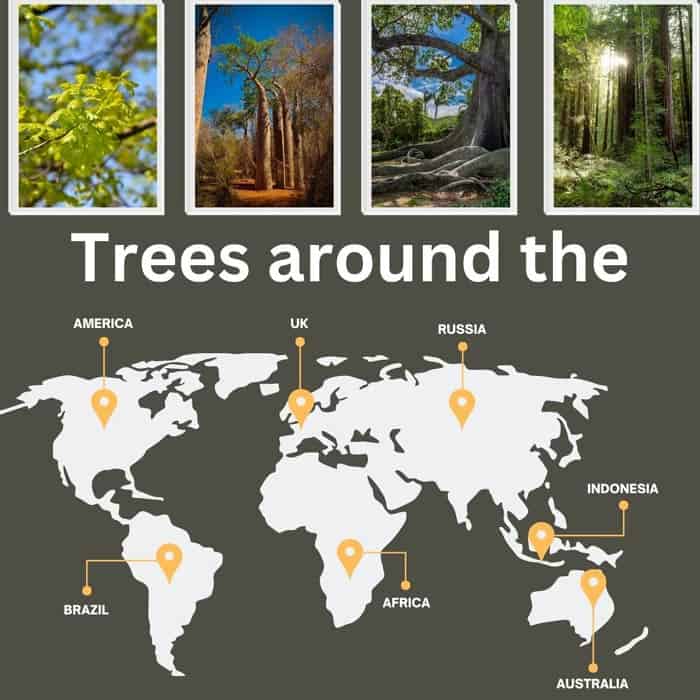
Trees are found worldwide, making them a global phenomenon. Each continent has its collection of tree species, which play a crucial role in their respective ecosystems[6].
- The English Oak (Quercus robur) is known for its strength and endurance in Europe[7]. Its acorns serve as a food source for animals. Its wood has been used in construction and shipbuilding for centuries. The Scots Pine (Pinus sylvestris) is another seen tree across the continent-spanning from Scotland to Russia.
- Asia is home to the Ginkgo (Ginkgo biloba), an ancient tree species often referred to as a living fossil. Recognized for its fan-shaped leaves, the ginkgo is admired for its resilience and longevity. With its roots and reaching canopy, the Banyan Tree (Ficus benghalensis) holds great significance in Asian culture.
- In Africa, the Baobab Tree (Adansonia) represents the essence of the continent. Its enormous trunk stores water and vitamin C-rich fruit, making it a vital resource in regions. The Acacia Tree (acacia), adorned with branches and spherical flowers, is commonly found throughout savannahs[8].
- Australia is famous for its Eucalyptus trees, which dominate its landscapes. These trees have successfully adapted to Australian conditions. They can withstand wildfires. Another unique tree found in Australia is the Boab, which is related to the baobab.
- South America is home to the awe-inspiring Amazon Rainforest, known for its various trees. One iconic species is the Kapok tree’s height and distinctive buttress roots. The Rubber Tree, a species that provides rubber, can also be found in this region.
- North America boasts a diversity of trees well, from the Coast Redwood along the Pacific Coast, which holds the title of the tree in the world, to the Sugar Maple of the Northeast, known for its vibrant fall colors and sweet sap.
Each tree species plays a role in maintaining our planet’s biodiversity and overall health. They provide habitats for species that contribute significantly to the carbon cycle and offer valuable resources that benefit people worldwide.
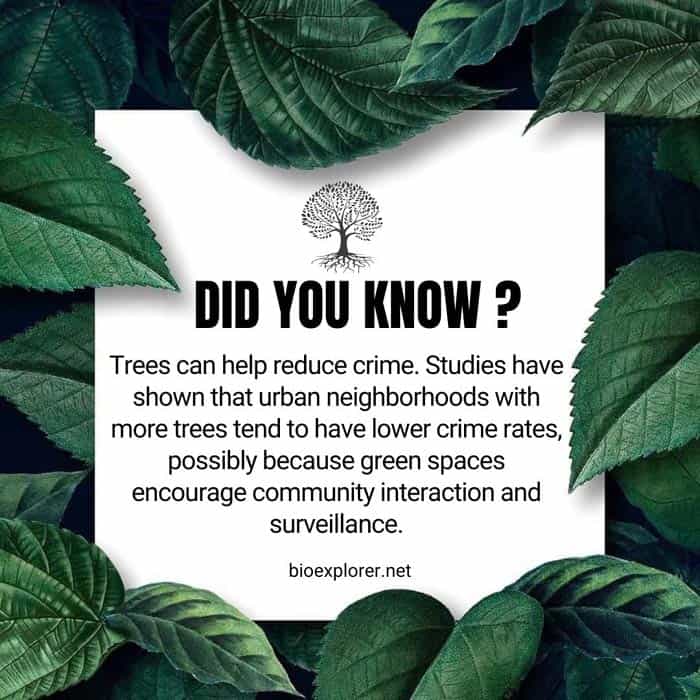
The Role of Trees in Ecosystems
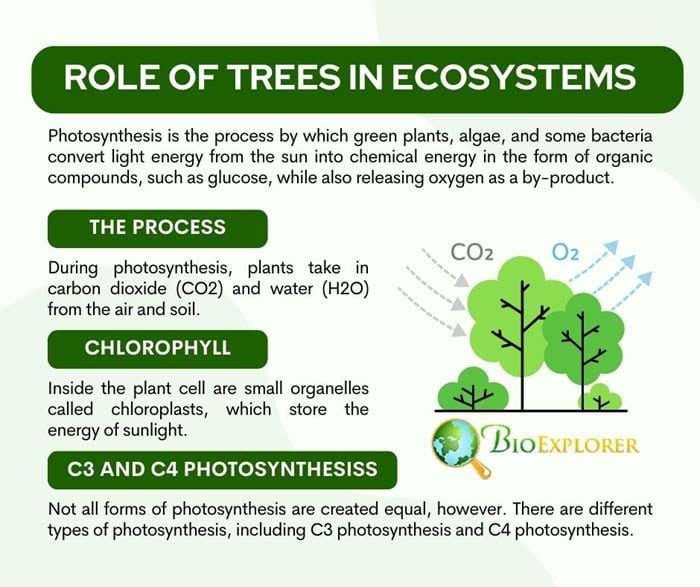
Trees play a role in our planet’s ecosystems, serving as the foundation for an environment. Often referred to as the “lungs of the Earth“. Trees absorb carbon dioxide (CO2), a greenhouse gas, and release oxygen (O2) essential for sustaining life. However, their ecological significance extends well beyond this function.
- Different types of trees fulfill roles within their ecosystems[9]. Deciduous trees such as oaks and maples provide a canopy during summer, shading the ground and allowing light to filter through during winter. This helps regulate the forest’s temperature and moisture levels, creating an environment that supports plant and animal species. As autumn arrives, these trees shed their leaves onto the ground, where they decompose and enrich the soil with nutrients that facilitate the growth of plants.
- Evergreen trees like pines and firs offer year-round shelter for wildlife from predators and harsh weather conditions. Their extensive root systems prevent soil erosion while maintaining soil health and stability. In regions, they also act as windbreaks by reducing wind speed and minimizing heat loss, providing niches for species to thrive.
- In rainforests, trees play a more intricate role in maintaining ecosystem balance. Tall majestic trees form a home for types of plants and animals ranging from birds and monkeys to insects and epiphytic plants that grow on their trunks and branches. These trees also play a role in the water cycle by releasing water from the soil into the atmosphere, forming clouds and eventually falling as rain.
- Underneath the leafy canopy are trees and shrubs that contribute to the layers of the forest. They provide a habitat for species that thrive in certain conditions. These trees often have leaves to capture as much sunlight as possible.
- In environments, trees such as Joshua Trees or Baobabs have evolved to store water in their trunks, which becomes a resource during drought. They also offer shade. Create habitats for desert-adapted species.
- Along coastlines and in mangrove ecosystems, trees like Mangroves play a role in stabilizing shores and mitigating the impact of storms and tsunamis. Their intricate root systems trap sediments while providing homes for a range of life.
Suggested Reading:
Explore The Layers Of The Rainforest
Conservation of Tree Species
Trees face various threats that pose risks to their survival.
- One of the challenges is deforestation, driven by activities like agriculture, logging, and urbanization. This does not result in the loss of tree species. It also disrupts entire ecosystems, impacting numerous species that rely on trees for their homes and food.
- Another major threat to tree species is climate change. Increasing temperatures, shifting precipitation patterns, and frequent extreme weather events can affect tree health and survival. For instance, warmer temperatures create conditions for pests and diseases to spread into areas, while drought weakens trees and makes them more vulnerable to such threats.
- The presence of species-plants and pests is another concern. These invaders can trees[10] or directly contribute to their decline. An example is the emerald ash borer, a beetle that has caused damage to Ash tree populations in North America.
Despite these challenges, efforts focus on conserving tree species. Protected areas such as parks and nature reserves serve as havens for tree species and the diverse wildlife that depends on them. Restoration projects aim to replant trees in areas where they have been lost, emphasizing species adapted to local conditions.
Suggested Reading:
Top 15 Current Environmental Issues in the US
Conclusion
Our journey through the realm of trees has been an adventure. We’ve traveled from the canopies of forests to the majestic heights of evergreen conifers. Along the way, we’ve marveled at the blooms of flowering plants. Witnessed the ancient cones of cone-bearing trees. Exploring tree species across regions in the United States and worldwide has given us an understanding of their significance in our ecosystems.
As a Greek[11] saying suggests, “Society grows great when old men plant trees whose shade they know they shall never sit in “. Let us continue planting and preserving trees for generations to enjoy their benefits.


